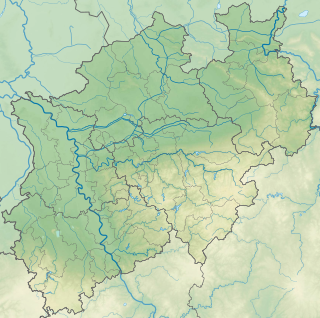Remscheider Bergland in the narrow sense
| Remscheider Bergland i. e. S. | |||
|---|---|---|---|
| Systematics according to | Handbook of the natural spatial structure of Germany | ||
| Greater region 1st order | Low mountain range threshold | ||
| Greater region 2nd order | Rhenish Slate Mountains | ||
| Main unit group | 33 → Süderbergland |
||
| About main unit | 338 → Bergische plateaus |
||
| 4th order region (main unit) |
338.0 → Mittelberg plateau |
||
| 5th order region | 338.06 → Remscheid Bergland |
||
| Natural space |
338.060 → Remscheider Bergland i. e. S. |
||
| Geographical location | |||
| Coordinates | 51 ° 11 '55 " N , 7 ° 11' 38" E | ||
|
|||
| local community | Remscheid , Wuppertal , Solingen | ||
| state | North Rhine-Westphalia | ||
| Country | Germany | ||
The Remscheid Bergland i. e. S. (in the narrower sense) is a natural spatial unit with the order number 338.060. The natural space unit with the order number 338.06 of the same name is superordinate.
It includes the valleys and surrounding elevations of the Morsbach , the Leyerbach , the Eschbach with the Eschbachtalsperre , the Lobach and the Sengbach with the Sengbachtalsperre . The mountainous region lies in the area of the large Berg cities of Wuppertal (districts of Ronsdorf and southern Cronenberg ), Remscheid (all districts except the eastern parts of Lüttringhausen and Lenneps , as well as the city center located on the Remscheider Schwelle ) and Solingen (district of Burg an der Wupper ), as well on smaller parts of the northern Wermelskirchen .
There is a strong shredded mountainous terrain with elongate ridges , forest residues and round tops , the high areas and Wupperfeld terrace residues with deep and steep-sided V-shaped valleys , locally Siepen called or Siefen is patterned. Geologically, the Remscheid Uplands mainly consist of Devonian and Silurian Grauwacken , slates , sandstones and quartzites .
On the heights, farms have settled in the spring hollows and in the valleys, water power was used by hammer mills and grinding docks. Row- like urban and industrial buildings are located on the terraces .
Individual evidence
- ↑ a b c Handbook of the natural spatial structure of Germany: Sheet 108/109: Düsseldorf / Erkelenz (Karlheinz Paffen, Adolf Schüttler, Heinrich Müller-Miny) 1963; 55 p. And digital version of the corresponding map (PDF file; 7.09 MB)
- Remarks
- ↑ The natural space unit 338.06 (Remscheid Bergland) is subdivided into the natural space units 338.060 (Remscheid Bergland in the narrower sense) and 338.061 ( Remscheider threshold ).
